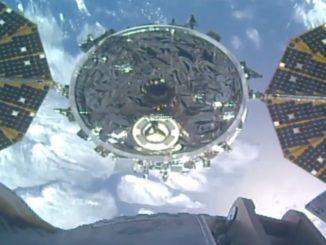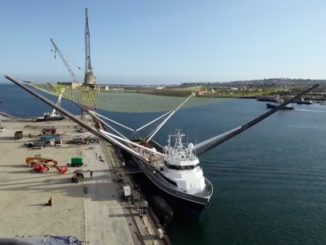
In the months following its fourth flight of it Alpha rocket, Firefly Aerospace continues to push forward with work on two new rockets in partnership with Northrop Grumman. On Wednesday, Firefly is set to hold a ribbon-cutting ceremony marking a manufacturing expansion to support the work flows on the Antares 330 rocket and its sequel, the Medium Launch Vehicle (MLV).
The expansion, which boosted its manufacturing space from 92,000 to 207,000 square feet, also includes a new engine test stand, with can withstand up to 230,000 pounds of thrust. This addition supports the test campaign for Firefly’s Miranda and Vira engines.
“After Firefly signed the MLV agreement with Northrop Grumman, we went immediately to work on our Briggs expansion, which has been completed in less than a year’s time,” said Bill Weber, CEO of Firefly Aerospace in a statement. “Along with the expansion, we’re taking advantage of automated machinery to further advance our rapid production schedule while improving efficiencies and lowering costs.”

Firefly and Northrop Grumman are aiming to launch the first flight of the Antares 330 rocket in 2025. Seven Miranda engines will power the first stage of this rocket, while Northrop Grumman’s Castor 30XL solid rocket motor will power the second stage, as it did for the Antares 230. Northrop Grumman is also providing both vehicle integration and launch pad operations up at NASA’s Wallops Flight Facility in Virginia.
Later that year, the companies are expected to debut the MLV. It will use the first stage developed for the Antares 330, but will feature a liquid-fueled upper stage and a single Vira engine. The Vira engine was previously referred to as a Miranda vacuum engine as recently as Nov. 2023.
Both the Antares 330 first stage and the MLV upper stage are being manufactured using carbon composite materials, similar to Firefly’s Alpha rocket as well as Rocket Lab’s Electron and Vaya Space’s forthcoming Dauntless rocket.
Firefly said it used a new automated fiber placement (AFP) machine from Ingersoll Machine Tools Inc. to build the first barrel that is being used for MLV development testing.
“Firefly’s new AFP machinery, which is already widely used and proven in the aircraft industry, is a significantly more efficient and cost-effective approach to rocket production and can be utilized for composite parts across our vehicle lines,” said Dan Fermon, COO of Firefly Aerospace, in a statement. “These high-speed robotic machines can lay up more than 200 pounds of carbon fiber per hour, allowing us to produce all the large carbon composite structures for Alpha in just seven days and MLV in just 30 days. This is about nine times faster and seven times cheaper than our former process using high-touch laser placement systems.”
While it’s working on this next rocket, Firefly is working towards getting back to flight with its Alpha rocket. Earlier this month, the company submitted its Mishap Investigation Report to the Federal Aviation Administration (FAA) regarding the issues it encountered during the fourth flight of its Alpha rocket.
Firefly said in a statement on Feb. 20 that it “is now implementing corrective actions to ensure the [Guidance, Navigation and Control] software issue is resolved, including process changes to detect and prevent similar issues in the future.”
Our dedicated team has completed the flight data review for Alpha FLTA004 and determined root cause after Alpha’s second stage did not achieve the target orbit for payload deployment. With corrective actions underway, Alpha will be ready to fly again in the coming months. Learn…
— Firefly Aerospace (@Firefly_Space) February 20, 2024
Future shot on goal
In addition to its projects as a launch provider, Firefly is also making headway towards its first mission to the Moon. The company is one of several selected as part of NASA’s Commercial Lunar Payload services program.
It’s Blue Ghost lander has begun payload integration at Firefly’s Cedar Park, Texas, campus ahead of the planned first mission set for later this year. Following that, it will undergo final environmental testing before being shipped down to Florida for launch.
Our second lunar payload is now on board Blue Ghost! @AegisAero's Regolith Adherence Characterization (RAC) will uncover how lunar regolith sticks to various materials to protect spacecraft, spacesuits, and habitats from abrasion. pic.twitter.com/SU55YacyBi
— Firefly Aerospace (@Firefly_Space) February 19, 2024



